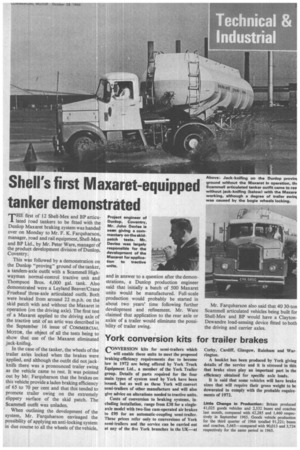Shell's first Maxaret-equipped tanker demonstrated
Page 41

If you've noticed an error in this article please click here to report it so we can fix it.
THE first of 12 Shell-Mex and BP articulated road tankers to be fitted with the Dunlop Maxaret braking system was handed over on Monday to Mr. F. K. Farquharson, manager, road and rail equipment, Shell-Mex and BP Ltd., by Mr. Peter Ware, manager of the product development division of Dunlop, Coventry.
This was followed by a demonstration on the Dunlop "proving" ground of the tanker, a tandem-axle outfit with a Scammell Highwayman normal-control tractive unit and Thompson Bros. 4,000 gal. tank. Also demonstrated were a Leyland Beaver/Crane Fruehauf three-axle articulated outfit. Both were braked from around 22 m.p.h. on the skid patch with and without the Maxaret in operation (on the driving axle). The first test of a Maxaret applied to the driving axle of the tractive unit of an artic was described in the September 16 issue of COMMERCIAL MOTOR, the object of all the tests being to show that use of the Maxaret eliminated jack-knifing.
In the case of the tanker, the wheels of the trailer axles locked when the brakes were applied, and although the outfit did not jackknife there was a pronounced trailer swing as the vehicle came to rest. It was pointed out by Mr. Farquharson that the brakes on this vehicle provide a laden braking efficiency of 65 to 70 per cent and that this tended to promote trailer swing on the extremely slippery surface of the skid patch. The Scammell outfit was unladen.
When outlining the development of the system, Mr. Farquharson envisaged the possibility of applying an anti-locking system in due course to' all the wheels of the vehicle, and in answer to a question after the demonstrations, a Dunlop production engineer said that initially a batch of 500 Maxaret units would be manufactured. Full-scale production would probably be started in about two years' time following further development and refinement. Mr. Ware claimed that application to the rear axle or axles of a trailer would eliminate the possibility of trailer swing. Mr. Farquharson also said that 40 30-ton Scammell articulated vehicles being built for Shell-Mex and BP would have a ClaytonDewandre load-sensing device fitted to both the driving and carrier axles.
























































































































